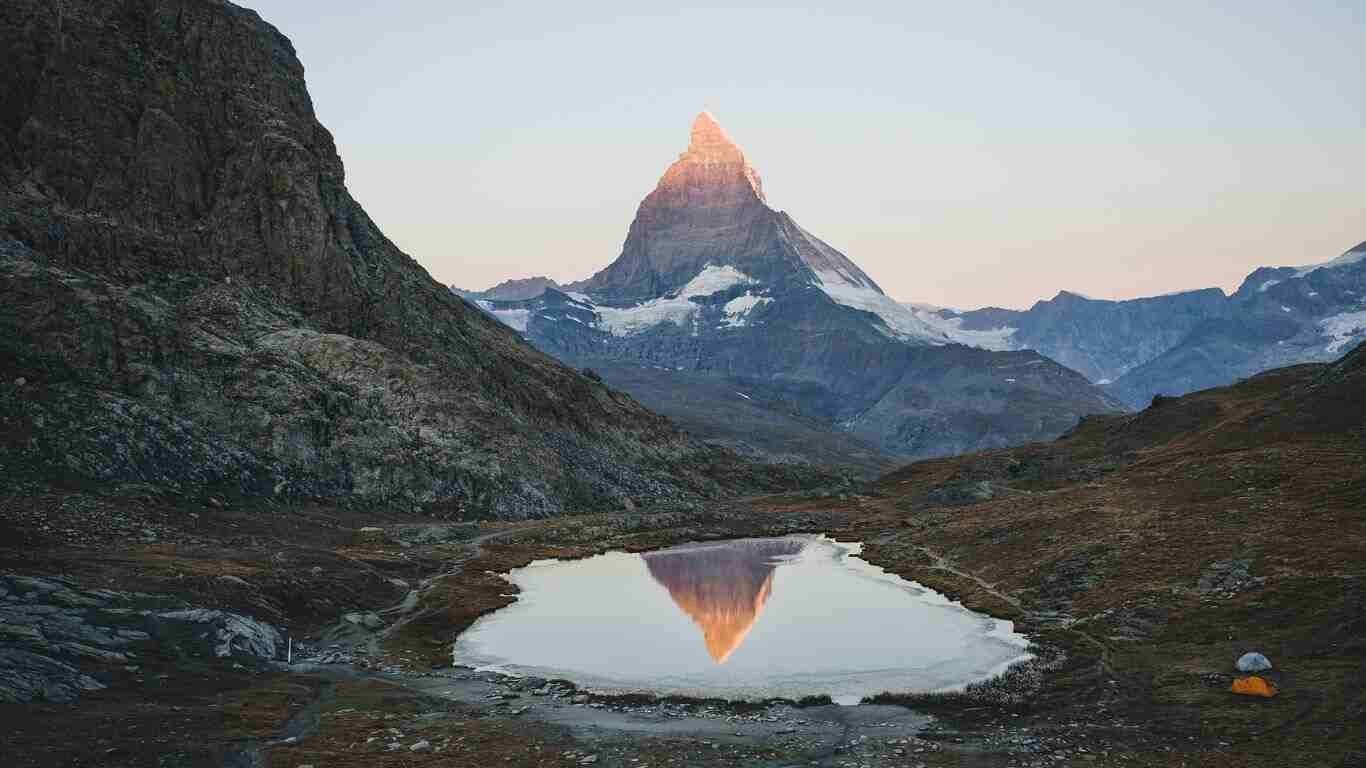
Table of Contents
ToggleIntroduction
The Matterhorn Mountain is a majestic symbol of the Alps, standing tall and domineering with a nearly perfect pyramidal shape. One of the tallest summits in the Alps, it is situated on the boundary between Switzerland and Italy and rises to a height of 4,478 meters (14,692 feet). In addition to being a marvel of nature, the Matterhorn Mountain serves as a representation of the breathtaking beauty of the alpine environment. For years, nature enthusiasts, photographers, and adventurers have been enthralled by its remarkable silhouette.
Beyond its breathtaking beauty, the Matterhorn Mountain captivates. It serves as the pinnacle of climbing difficulty, a wellspring of creative inspiration, and a profound symbol of the might and majesty of the natural world. The Matterhorn Mountain offers a singular and remarkable experience, regardless of whether you are a seasoned mountaineer, a casual hiker, or just a fan of the outdoors.
The History of The Matterhorn: A Timeless Icon
There has been both tragedy and success in the long and illustrious history of the Matterhorn Mountain. When Edward Whymper and his team successfully completed the mountain’s first climb on July 14, 1865, it became well-known around the world. Although it came at a heavy price, this historic climb represented a turning point in the history of mountaineering. Four participants of the trip perished in a horrific event that happened during the descent. This incident highlighted the inherent risks of climbing at high altitudes and solidified the Matterhorn Mountain’s image as a hard undertaking.
The Matterhorn Mountain was regarded as a mysterious and hallowed mountain by the locals before its first climb. Representing the unadulterated might and splendor of the natural world, the peak was revered. Because of its striking silhouette, the Matterhorn Mountain has been deeply ingrained in Italian and Swiss culture as well as innumerable literary and artistic creations.
Apart from its dramatic past, the Matterhorn Mountain has been instrumental in shaping the evolution of contemporary mountaineering techniques. A pivotal character in the history of climbing, the Matterhorn Mountain is known for its technical difficulties and the dramatic tales surrounding its ascents, which have influenced the development of climbing methods and gear.
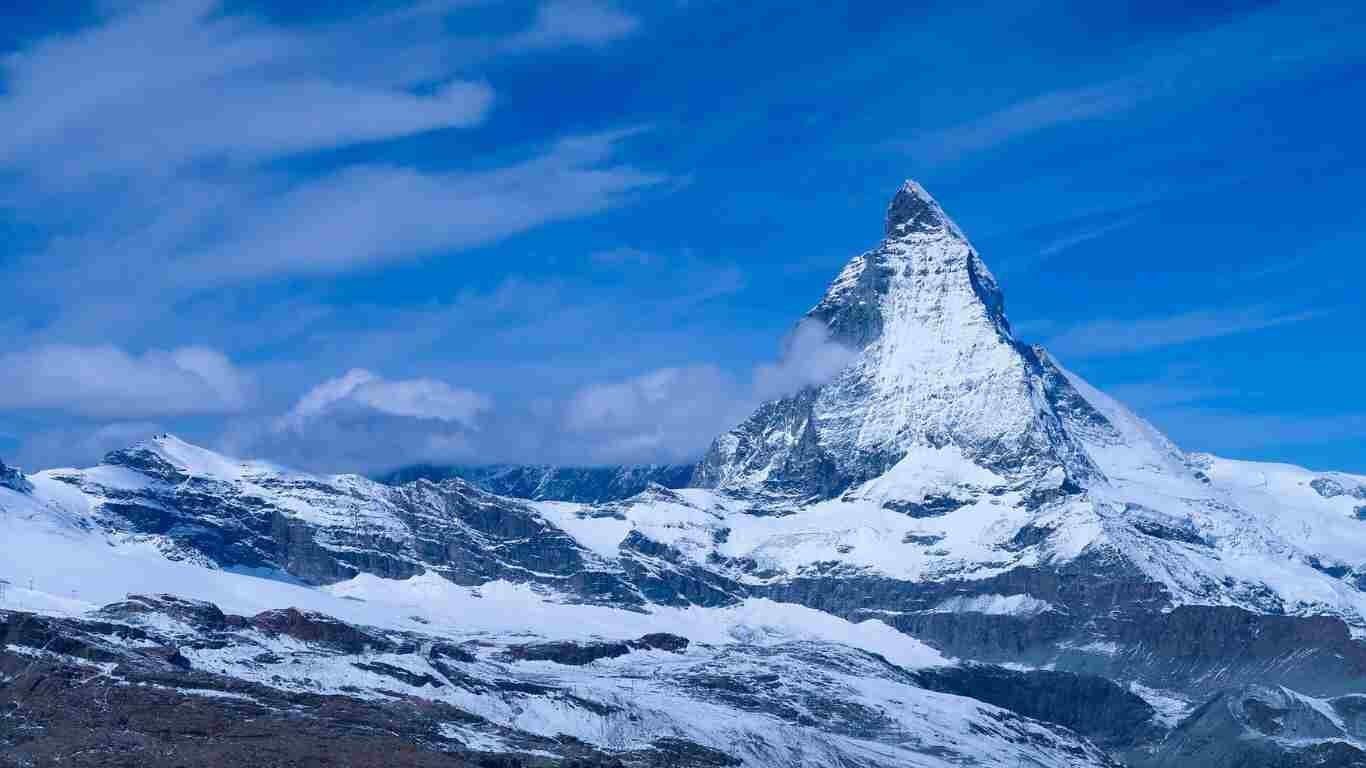
Geological Wonders of The Matterhorn
Shaped by the powerful forces of nature, the Matterhorn Mountain is a geological marvel. The mountain is the product of the African and Eurasian tectonic plates colliding during the Alpine orogeny, which took place about 50 million years ago. The Alps were raised as a result of this massive geological activity, and the Matterhorn Mountain was created.
Erosion and glaciation over many years have sculpted the mountain into its characteristic pyramid shape. Gneiss, granite, and sedimentary rocks are among the different types of rock that make up Matterhorn Mountain. The mountain’s striking contour and rough exterior are a result of these geological features. Due to the way these various rock types interact, the Matterhorn Mountain is an important location for scientific study because it produces an intricate and intriguing geological environment.
An essential site for researching Earth’s history is the Matterhorn Mountain, which was formed by geological processes. To learn more about the geological processes that generated the Alps and the effects of glaciation on mountain landscapes, geologists and researchers study the rock formations on the mountain.
Climbing the Matterhorn: A Mountaineer’s Dream
In the world of mountaineering, climbers consider the Matterhorn Mountain to be one of the greatest obstacles. Serious climbers see it as a desirable target because of its high slopes, complex routes, and erratic weather. A historic first ascent, the Matterhorn Mountain Climb also brought attention to the dangers and difficulties that come with climbing at high altitudes.
These days, ascending the Matterhorn Mountain calls for thorough planning and consideration for the risks involved. Usually, one of the several well-known routes—each with unique difficulties—is used for the ascent. The most popular route, Hörnli Ridge, is renowned for its comparatively easy climb and technical difficulty. The Hörnli Hut serves as the starting point for climbers and offers crucial shelter and support prior to the ascent.
The Matterhorn Mountain offers a number of Italian routes in addition to the Hörnli Ridge, such as the Lion Ridge and Italian Ridge. These courses offer different paths with different degrees of difficulty. Starting near the Carrel Hut, the Lion Ridge is renowned for its technical intricacy and requires a large amount of rock climbing. Though less frequented, the Italian Ridge necessitates advanced climbing expertise.
There is more to climbing the Matterhorn Mountain than just technical proficiency. Climbers need to be ready for quickly shifting weather patterns, erratic snow and ice conditions, and the risks that come with mountaineering at high altitudes. A successful and safe climb requires proper acclimatization, physical preparation, and the use of the right equipment.
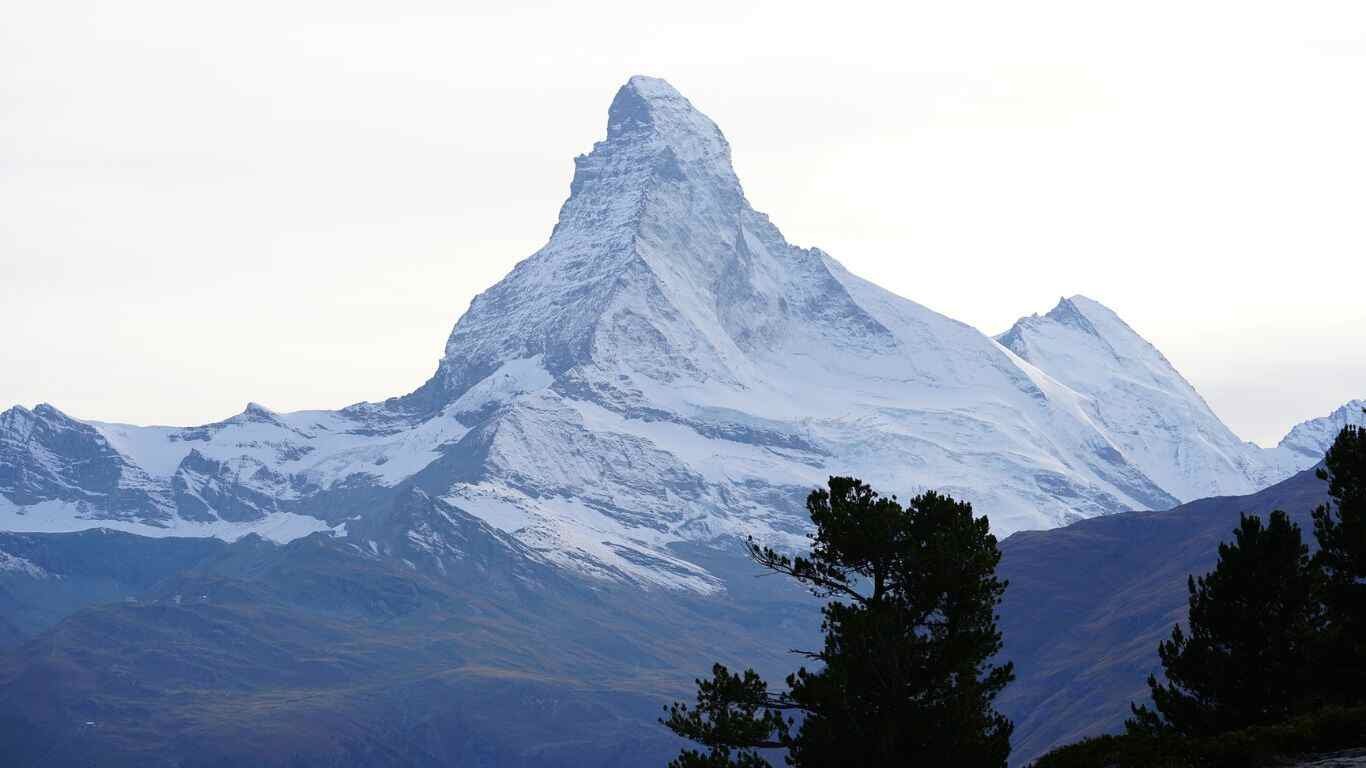
The Best Routes to Conquer The Matterhorn
There are various climbing routes available atop the Matterhorn Mountain, each with special features and difficulties. The type of adventure you seek, your ability level, and your climbing experience will all play a role in selecting the best route.
Hörnli Ridge
Climbing the Matterhorn Mountain is most popular and accessible via the Hörnli Ridge. Climbers encounter a combination of rock climbing and scrambling beginning at the Hörnli Hut. Although the route is thought to be less technically difficult than other paths, it nevertheless calls for a high degree of ability and athleticism.
Lion Ridge
The Carrel Hut is the starting point of the technically challenging Lion Ridge. There is a lot of rock climbing on this route, so you need to be really skilled and experienced. A less popular and more difficult option to the Hörnli Ridge is the Lion Ridge.
Italian Ridge
An alternative route to the Matterhorn Mountain’s summit is via the Italian Ridge. This route’s complicated terrain and technical difficulties require advanced climbing abilities and experience. It is appropriate for experienced climbers looking for a more secluded experience and provides a unique viewpoint of the mountain.
Zmutt Ridge
A less well-known route that provides a distinct climbing experience is Zmutt Ridge. It offers a more remote and hard approach with a mix of rock and ice climbing parts. For those looking for a difficult and remote climb, the Zmutt Ridge is the perfect option.
Every route atop the Matterhorn Mountain necessitates meticulous planning, physical readiness, and knowledge of the terrain. Climbers need to be ready for variable weather, technical difficulties, and the risks that come with climbing at high altitudes.
Wildlife and Ecosystem Around The Matterhorn
In addition to being a haven for climbers, the Matterhorn Mountain is home to a thriving and varied environment. Many different kinds of plants and animals can be found in the mountain’s environs due to its varied ecosystems and heights. The Matterhorn Mountain’s alpine environment provides various ecological zones, each of which supports a distinctive fauna and vegetation.
Species including the Alpine ibex, chamois, and marmots can be found in the Matterhorn Mountain region at lower elevations. The majestic curled horns of the Alpine ibex are a well-known icon of the high Alps. In the lower portions of the mountain, chamois are frequently spotted due to their gracefulness and agility. With their characteristic whistles and gregarious ways, marmots lend a certain beauty to the scenery of the mountains.
Surrounding the Matterhorn Mountain is equally impressive flora. The severe circumstances of the high-altitude habitat are ideal for alpine plants like alpine gentian and edelweiss. These plants have developed special adaptations to live in the nutrient-poor, stony soil. Edelweiss, for instance, is shielded from the cold and UV light by its thick fuzzy hairs.
The ecological value of the Matterhorn peak is enhanced by the variety of animals and plants that inhabit the peak. To maintain this alpine ecosystem’s delicate balance and guarantee that future generations can still enjoy its natural beauty, conservation measures are crucial. The wellbeing of this special ecosystem depends on actions taken to preserve the habitat used by the species of the Matterhorn Mountain and to regulate human activity.
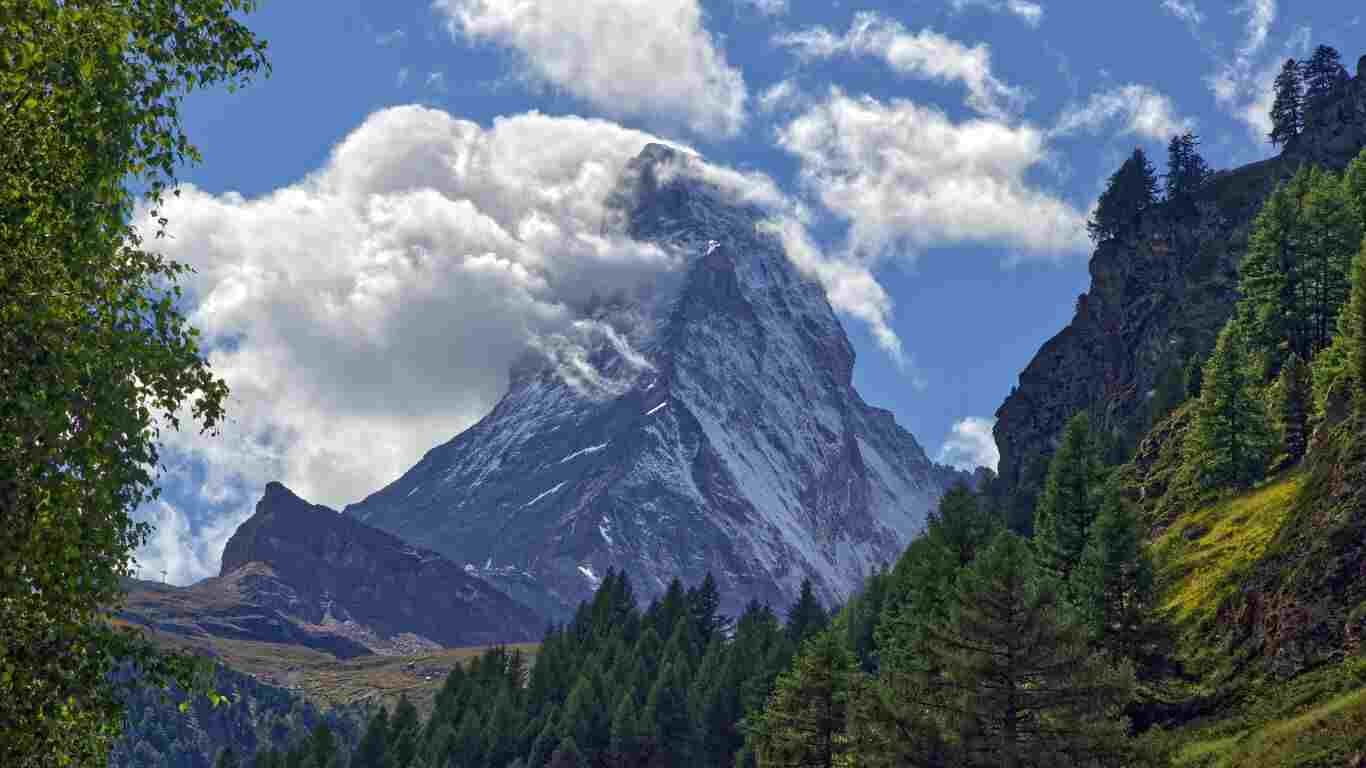
Seasonal Beauty: Visiting The Matterhorn Year-Round
A popular tourist destination all year round, the Matterhorn Mountain provides a breathtaking display of seasonal beauty. Every season offers chances for discovery and its own distinct appeal.
Winter
In winter, the Matterhorn Mountain transforms into a snow-covered wonderland. The surrounding slopes become a haven for skiers and snowboarders, offering excellent conditions for winter sports. The snow-covered peak creates a striking contrast against the crisp winter sky, providing a picturesque setting for winter activities.
Spring
When the snow starts to melt and the wildflowers bloom in the spring, the landscape is revitalized. The fields beneath Matterhorn Mountain burst with color, while the melting snow exposes undiscovered pathways and routes. The mountain’s lower elevations make for wonderful trekking and exploration in the spring, when the flowering flowers color the surrounding scenery with vivid tones.
Summer
Hiking and mountaineering are most popular in the summer. Access to the trails is available, and the weather is usually more steady. Clear blue skies and verdant mountain meadows provide a wonderful setting for outdoor pursuits. At this time, many people seek to reach the summit of the Matterhorn Mountain, which is a popular climbing destination. The summer months also present chances for trekking, glacier skiing, and trail exploration on the mountain.
Autumn
There’s something more sedate and entrancing about autumn. In stark contrast to the mountainous peaks of the Matterhorn Mountain, the alpine larch trees turn a beautiful gold color. For leisurely hikes and photography, the changing hues and clear air create a stunning backdrop. Fall offers pleasant outdoor exploration because of the changing foliage and golden hues that blanket the area.
Each season provides a different perspective of the Matterhorn Mountain and offers unique opportunities for outdoor adventures and exploration. Whether you visit in winter, spring, summer, or autumn, the Matterhorn Mountain promises an unforgettable experience.
Matterhorn’s Place in Swiss and Italian Culture
Swiss and Italian cultures both place great importance on the Matterhorn Mountain. The mountain represents Switzerland’s natural heritage and serves as a national symbol. The silhouette of it is widely represented in Swiss literature and art, and it is even depicted on the packaging for the renowned Toblerone chocolate.
The Matterhorn Mountain, often referred to as Monte Cervino in Italy, is a significant cultural landmark. Celebrated in Italian tradition and culture, it is a notable landmark in the Aosta Valley. The mountain’s significance as a common asset and a representation of the alpine region’s natural beauty is highlighted by its presence in both Swiss and Italian cultures.
Beyond its actual existence, the Matterhorn Mountain has cultural importance. It stands for the adventurous spirit, the splendor of the natural world, and the perennial appeal of the alpine setting. The mountain continues to be a source of intrigue and admiration for innumerable writers, painters, and adventurers.
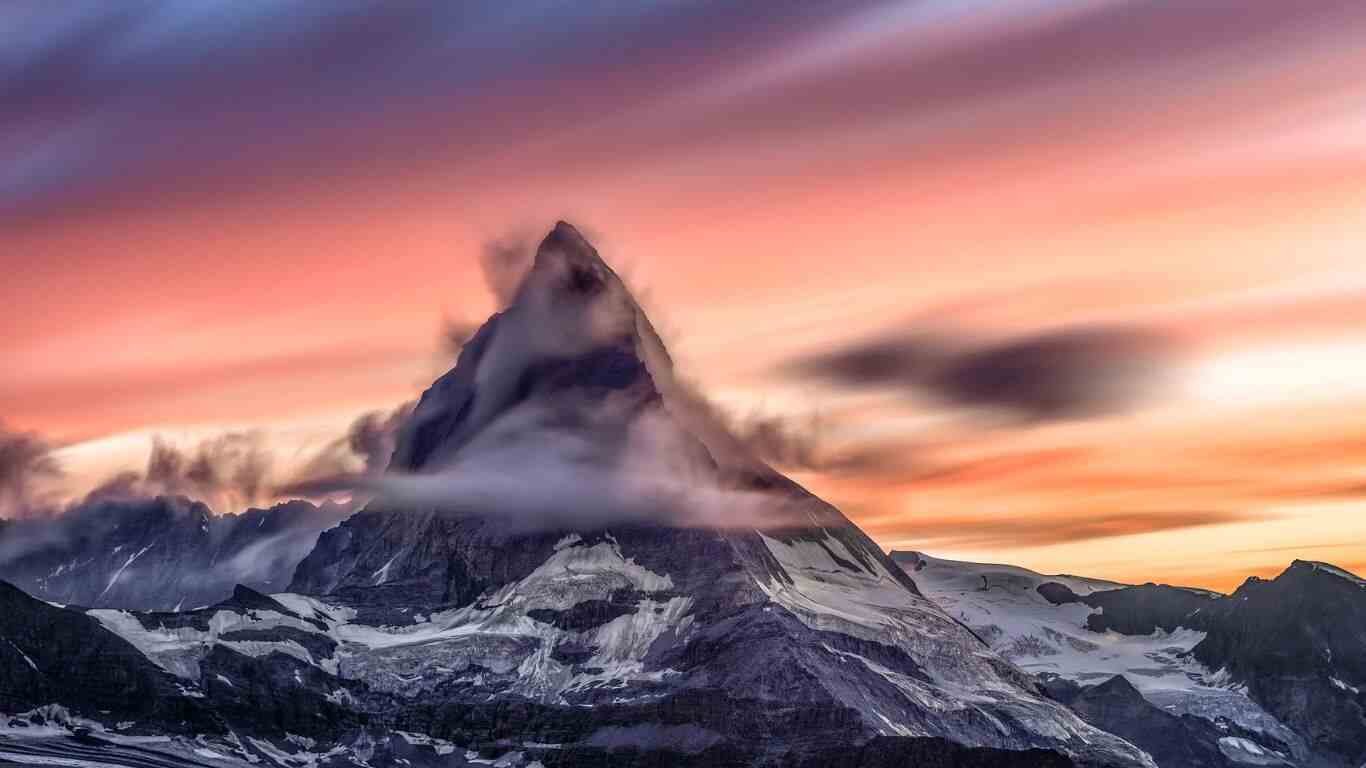
Safety Tips for Exploring The Matterhorn
Planning ahead and following safety precautions are essential when exploring the Matterhorn Mountain. The difficult conditions on the mountain require preparation and respect. For anyone intending to visit or climb the Matterhorn Mountain, here are some crucial safety advice:
Check Weather Conditions
On the Matterhorn Mountain, the weather can shift quickly. Always check the weather before leaving, and be ready for unforeseen changes in the weather. It’s important to plan for the possibility of unpredictable weather on the mountain.
Equip Yourself Properly
Make sure you have the appropriate equipment, such as safety gear, climbing gear, and warm clothes. To climb the Matterhorn Mountain, you’ll need technical gear and appropriate boots. Ensure that your equipment is in good working order and appropriate for the circumstances you will be facing.
Hire a Guide
If you’re not a skilled climber, you might want to hire a guide. They can improve your safety on the mountain, offer insightful information, and assist with route planning. Guides can help with navigation and decision-making as they possess in-depth knowledge of the situations on the Matterhorn Mountain.
Stay Acclimatized
Avoiding altitude sickness requires proper acclimatization. Prior to making the Matterhorn Mountain summit attempt, spend some time at higher elevations. As you ascend higher into the atmosphere, your body must acclimate to the lower oxygen levels.
Know Your Limits
Climbing the Matterhorn Mountain is difficult. To guarantee a safe and enjoyable encounter, honestly evaluate your experience and level of fitness. Don’t push yourself too hard, and be ready to back down if things get too difficult.
Understand Avalanche Risks
Recognize the danger of avalanches, particularly in the winter and spring. When entering a region that is prone to avalanches, make sure you are aware of the snow conditions and speak with local experts to determine the risk of avalanches.
Carry Emergency Supplies
Always keep an emergency kit with you, along with enough food and water, a map, a compass, and a GPS gadget. In remote and high-altitude environments, safety depends on being ready for crises.
Photography Hotspots: Capturing The Matterhorn’s Majesty
There are plenty of chances to photograph the Matterhorn Mountain’s amazing splendor. Here are some of the best locations for photographers to capture the Matterhorn Mountain’s majesty:
Gornergrat
A comprehensive view of the Matterhorn Mountain and the neighboring peaks may be obtained from the Gornergrat viewpoint. Here, you may get great wide-angle photos of the mountain with easy access provided by the Gornergrat Railway.
Riffelalp
Lower in altitude than the Matterhorn Mountain, Riffelalp provides a lovely foreground. Perfect for encapsulating the spirit of the alpine scenery, the historic Swiss chalets and alpine meadows form a stunning composition.
Hörnli Hut
Climbers can enjoy a spectacular viewpoint of the Matterhorn Mountain from the Hörnli Hut. Taking pictures of the mountain from this angle gives you a sense of the stunning scenery and the experience of climbing it.
Zermatt Village
Classic views of the Matterhorn Mountain may be found in the village of Zermatt. Photographs taken from this spot in the early morning or at sunset display the mountain in its most striking light, with the village serving as a charming foreground.
Matterhorn Glacier Paradise
A beautiful view of the Matterhorn Mountain from above is provided by this high-altitude viewpoint. For taking aerial photos of the mountain and the surrounding glaciers, Glacier Paradise is an excellent spot.
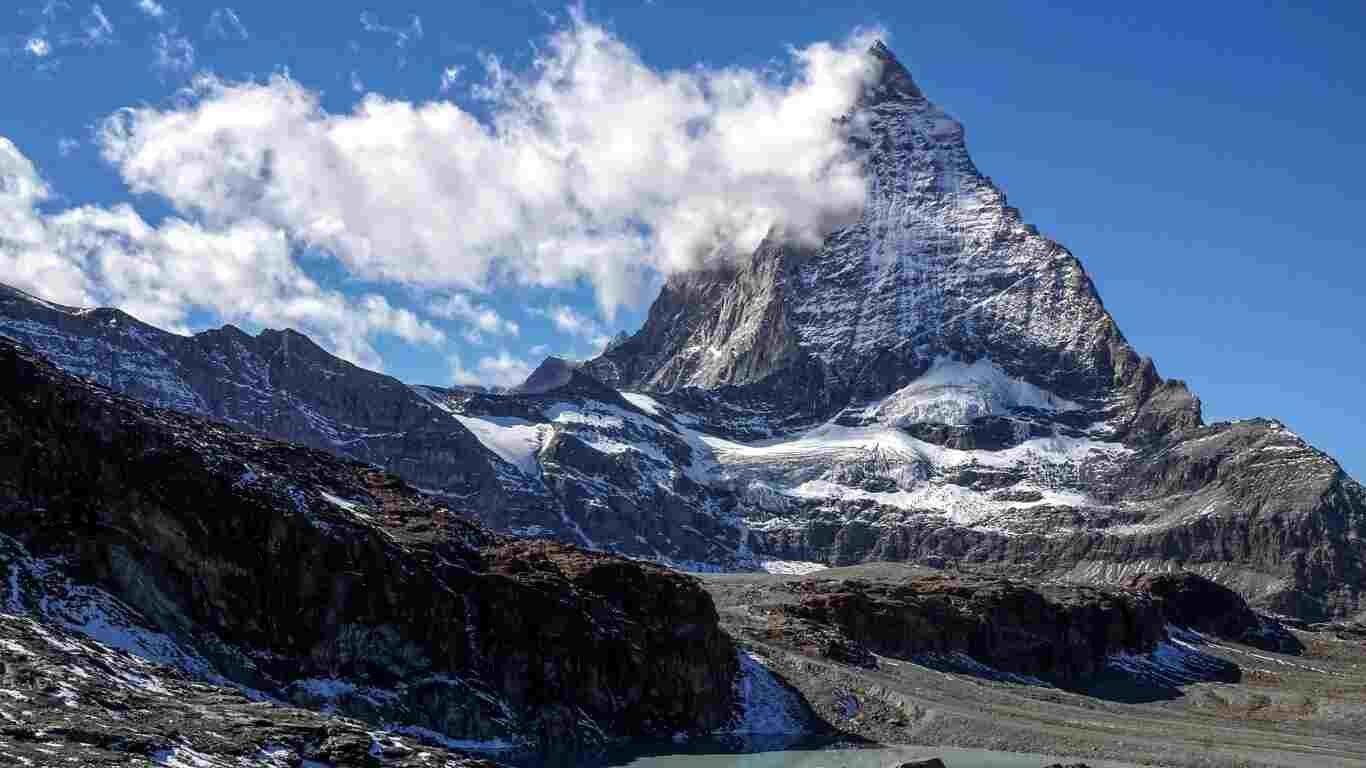
Adventure Activities Around The Matterhorn
Offering an abundance of activities that appeal to both thrill-seekers and environment lovers, the Matterhorn Mountain region is a haven for adventure aficionados. The Matterhorn Mountain region is home to a number of well-liked adventure activities:
Skiing and Snowboarding
Winter activities are well-suited to the slopes surrounding the Matterhorn Mountain. There is skiing available all year round at Matterhorn Glacier Paradise, with a range of runs appropriate for varying ability levels. For the more daring riders, the region offers off-piste riding and snowboard parks.
Hiking and Trekking
Around the Matterhorn Mountain, there are several trails suitable for different skill levels. Popular trails like the Five Lakes Walk provide breathtaking views of the Matterhorn Mountain reflected in alpine lakes. Hiking routes like the Matterhorn Glacier Trail offer chances to explore high-altitude scenery and glaciers.
Paragliding
Think about paragliding for a thrilling and different way to see the Matterhorn Mountain. Gaining an unparalleled aerial perspective of the mountain’s remarkable attributes and the encompassing alpine terrain is possible when you soar above the summits. Tandem paragliding with qualified instructors is provided by a number of local businesses.
Mountain Biking
Trails for mountain bikers can be found all around the Matterhorn Mountain. The routes offer a thrilling journey with a combination of difficult terrain and beautiful views. Zermatt and the neighboring areas include bike rental shops that loan out gear and offer advice on how to explore the terrain.
Rock Climbing
Apart from the conventional mountaineering, rock climbing is another activity available in the Matterhorn Mountain region. There are numerous climbing routes and crags in the area that accommodate climbers of all skill levels, from novices to experts. Climbing here is an unforgettable experience due to the challenging terrain and breathtaking landscape.
Planning Your Matterhorn Expedition: Travel Tips and Essentials
To guarantee a seamless and delightful experience, meticulous planning is necessary when organizing a trip to the Matterhorn Mountain. The following are some crucial pointers for organizing your expedition:
Book in Advance
Particularly in the busiest times of year, lodging and guided climbs may fill up rapidly. To reserve the dates and services of your choice, plan and book your trip well in advance. If you want to participate in any special activities, reserve your rooms, guides, and other services in advance.
Pack Wisely
Bring the right clothes and equipment for the activities you want to engage in. On the Matterhorn Mountain, layers are crucial for navigating the changing weather. Make sure you have all the gear you’ll need, such as safety gear, hiking boots, and climbing gear. Bring appropriate cold-weather clothing and accessories if you intend to participate in winter activities.
Physical Preparation
Make sure your body is ready for the tasks you intend to perform. A considerable degree of endurance and fitness are need to climb the Matterhorn Mountain. Train and condition yourself to meet the demands of the climb. If you’re new to climbing, you might want to learn more about the sport by enrolling in a course or going on guided climbs.
Respect Local Regulations
To protect the environment and guarantee a safe experience, abide by local laws and ordinances. Respecting these rules makes it easier to preserve the delicate alpine ecology and enhances the enjoyment of the trip for everyone. Observe fauna and flora, and stick to authorized pathways and trails.
Prepare for Altitude
Your performance and health may be impacted by the Matterhorn Mountain’s high altitude. Avoid vigorous exercise during the acclimatization phase, drink plenty of water, and rise gradually to prevent altitude sickness. See local guides or specialists for guidance on handling problems related to altitude.
Emergency Preparedness
Carry basic supplies like a first aid kit, a map, a compass or GPS device, enough food, and water to last you through any emergency. Learn the emergency protocols and how to get in touch with the local authorities.
Conclusion: The Matterhorn Mountain – A Natural Masterpiece to Behold
A monument to the astounding majesty and beauty of nature is the Matterhorn Mountain. It is unlike any other destination because of its eye-catching look, fascinating history, and wide variety of activities. The Matterhorn Mountain provides a unique experience, whether you are drawn to it by the difficulty of climbing, the beauty of its unspoiled surroundings, or its cultural significance.
Everybody who sees the Matterhorn Mountain is enthralled and inspired by it, both for its natural marvels and its significance to the local way of life. It is still a representation of beauty, adventure, and the never-ending spirit of discovery, serving as nature’s greatest work of art. Awed by the ageless splendor of one of the finest natural landmarks in the world, Matterhorn Mountain welcomes you to experience its majesty and embrace its challenges.
